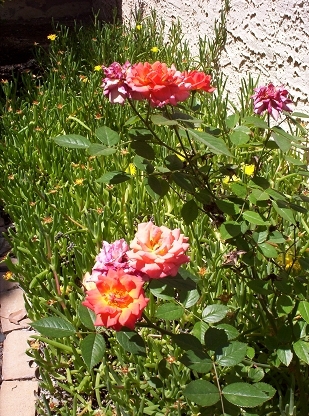|
 Photo
Photo
The photo on the right is of a miniature rose variety named "Heavenly Days",
and was taken in the middle of April. This plant has been in the
ground for more than three years and has been very low maintenance. It
was planted in the fall, in October, as a tiny container plant which was
ordered through the mail from a specialized supplier. After three years,
it is finally starting to look well established and is filling out. It
is located on the South side of a court yard wall. The courtyard
is on the North East side of the house so the rose gets late afternoon
shade, but is in full sun for most of the day.
Overview
Roses grow fairly well in the Phoenix area in general and miniature roses are
even easier to grow than your average full size rose. They take the desert heat and
sun fairly well and cold weather is not a problem as all types of roses can take much colder
temperatures than occur in the lower desert. In fact, roses never go fully dormant here. Roses need
regular water, especially in the summer.
Heat Tolerance and Sun Exposure
While roses prefer full sun to produce flowers, afternoon summer sun will make flowers short lived,
so extreme microclimates like Western exposure with reflected sun should be avoided.
Cold Tolerance
Roses are fully hardy in the Phoenix area. Miniature roses, unlike most named roses, are
grown on their own roots, meaning that they can freeze back and will return true to form
in the spring.
Planting
To maximize a roses chance of surviving its first summer, plant it in October.
At this time, the hot days are over and the plant will have as much time as
possible to grow roots before next summer.
Dig a hole at least twice the size of the rootball. At a minimum, make the
hole 2 feet in diameter and 2 feet deep. It also is a good idea to finish with the
hole an inch or two recessed so that a watering basin is formed.
Work in a 50/50 mix of compost to soil.
Be sure to mix the compost and soil
as thoroughly as possible. In the bottom of the hole, add a layer of this compost
mix combined with bonemeal or superphosphate.
Follow the directions on the bag to
determine quantity. Phosphorus encourages root growth but moves
slowly through the soil so it is good to take advantage of the opportunity to
put it down deep during planting.
Watering frequency
Miniature roses do well on a grass watering schedule.
Watering method
Basin or flood irrigation
is recommended because it helps keep the salt in our salty
water from accumulating around the roots. Furthermore, deep watering
will encourage the plant to develop deeper roots, making the plant tougher when the weather
gets hot and dry.
Fertilizing and Growth Rate
Entire books have been written on the intricacies of fertilizing roses.
Fortunately, healthy miniature roses with beautiful flowers can be grown
with very little care. A one inch layer of compost
applied in the spring and fall can go a long ways in making a rose happy. Nutrients
will be supplied as the compost decomposes and it will also help to keep the soil
around the rose more moist and cool. Miniature roses have relatively shallow roots so
this extra insulation can make a big difference.
Chemical fertilizers and organic fertilizers can be used as well.
It is best to use a bloom producing variety which are generally low in Nitrogen
and high in potassium and phosphorus.
Keep in mind that Phoenix soils are high in salts already and chemical fertilizers
contain salts. Therefore, it is very easy to burn plants with chemicals, so go very
light on them. It might be worthwhile to try the pure compost approach first before
trying anything stronger, then graduate to organic fertilizers if needed. Organic
fertilizers generally provide nutrients by degrading over time and are therefore
less likely to damage the plant than chemical fertilizers.
Pests
Aphids are the main pest of miniature roses. Fortunately, the aphid season is very short
in the lower desert, lasting from the beginning of March to the middle of April.
Aphids can usually be ignored on well established plants, because they aren't around long
enough to do significant damage.
On newly planted roses, they can be either periodically sprayed off with the hose or
killed using chemical means.
Chemical sprays that include bifenthrin appear to work the best because they continue to kill
for over two weeks. One spraying in the spring, when aphids appear,
is usually all that is needed. Pesticides
should be used minimally if at all.
Miniature roses do not appear to have troubles with black spot like their larger
relatives.
Propagation
Miniature roses are propagated from cuttings.
Links to more rose information
Mesa - East Valley Rose Society
Rose Magazine
|
 Book the Phoenix Tropicals Condo on Kiahuna Beach, in Kauai, Hawaii
Book the Phoenix Tropicals Condo on Kiahuna Beach, in Kauai, Hawaii